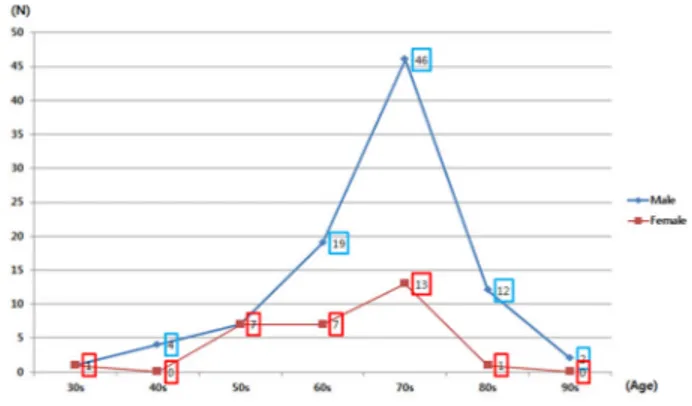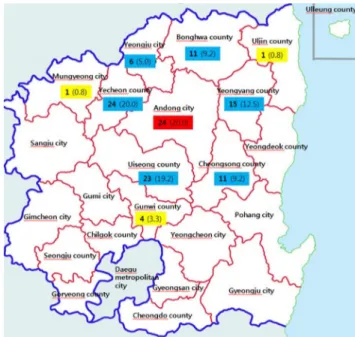Received: May 10, 2017 Revised: July 4, 2017 Accepted: July 8, 2017 TRAUMA AND INJURY
Correspondence to
Chan Yong Park, M.D., Ph.D.
Department of Trauma Surgery, Pusan National University Hospital, 179 Gudeok- ro, Seo-gu, Busan 49241, Korea Tel: +82-51-240-7369 Fax: +82-51-240-7719 E-mail: wkafyddl@hanmail.net
Analysis of Cultivator-related Trauma Cases in a Regional Trauma Center in the Rural Area of Gyeongbuk Province
Ui Kang Hwang, M.D., Ph.D.
1, Seok Hwa Youn, M.D.
1, Chan Yong Park, M.D., Ph.D.
21
Department of Trauma Surgery, Andong Medical Group Hospital, Andong, Korea
2
Department of Trauma Surgery, Pusan National University Hospital, Busan, Korea
Purpose: To analyze the data of patients who suffered trauma in a cultivator accident and visited the trauma center in rural Gyeongbuk Province.
Methods: We retrospectively reviewed the medical records and Korean Trauma Data Bank data of 120 patients who suffered cultivator-related traumas and visited the rural regional trauma center in Gyeongbuk Province from January to December 2015.
Results: The age of the patients ranged from 35 to 96 years (mean, 70 years). Ninety-one (75.8%) patients were men, and twenty-nine (24.2%) were women. Most of the patients were in their 70s (46 men [50.5%] and 13 women [44.8%]). In total, 113 patients (94.1%) arrived at the regional trauma center by ground transport and 7 (5.9%) arrived by air transport. Ninety-eight patients (81.7%) were transported to the regional trauma center directly from the scene of the accident, and twenty-two (18.3%) were transferred from another medical institute. The mean time from the accident to arrival at the emergen- cy department was 139 minutes, and only 46 patients (38.3%) arrived within 1 hour.
Twelve (10.0%) patients died, including two deaths on arrival and two post- cardiopul- monary resuscitation deaths in the emergency department. All deaths were of male cul- tivator operators. The causes of death were shock (hypovolemic, traumatic, or septic), subdural hematoma (open), hemothorax, rhabdomyolysis, and pneumonia.
Conclusions: As the government - led regional trauma center project is on process, it would be clinically important to summarize the initial outcome of cultivator injuries, which are characteristically found more in regional trauma centers in the rural area, and have high mortality. Based on this study, in the future, it will be necessary to fol- low up and analyze more number of patients and to construct accurate database about trauma cases related to cultivator in Gyeongbuk region.
Keywords: Trauma; Agriculture; Transportation; Treatment
Analysis of Cultivator-related Trauma Cases in a Regional Trauma Center in the Rural Area of Gyeongbuk Province
Ui Kang Hwang, M.D., Ph.D.
1, Seok Hwa Youn, M.D.
1, Chan Yong Park, M.D., Ph.D.
21
Department of Trauma Surgery, Andong Medical Group Hospital, Andong, Korea
2

